Error Alerting
In this microlearning, we’ll explore how to create and customize error alerts within your eMagiz environment. This functionality allows you to create a trigger that will generate an alert, as well as send you a notification, whenever error messages with certain conditions are raised. We’ll cover the trigger checks that are available for the error alerting and guide you through configuring them to suit your requirements. This will help you ensure your error alerts are as effective and relevant as possible. Should you have any questions, please contact academy@emagiz.com.
1. Prerequisites
- Basic knowledge of the eMagiz platform
- Basic knowledge of alerting in the eMagiz platform
2. Key concepts
This microlearning focuses on creating and customizing the error alerts that are existing in each of the environment of your model (i.e., Testing-Acceptance-Production).
- There are four checks that eMagiz currently provides that will raise an alert from the error messages:
- Message header
- Exception class
- Exception message
- Runtime check
- Recipients are defined on each error alert trigger.
3. Error Alerting
Error alerting refers to the configuration of triggers that will generate an alert, as well as send you a notification, whenever error messages with certain conditions are raised. This functionality is most likely relevant when an alert needs to be generated whenever a specific error message with certain characteristics (e.g., a particular header value or a particular exception message) is raised and that alert needs to be sent to a different set of recipients.
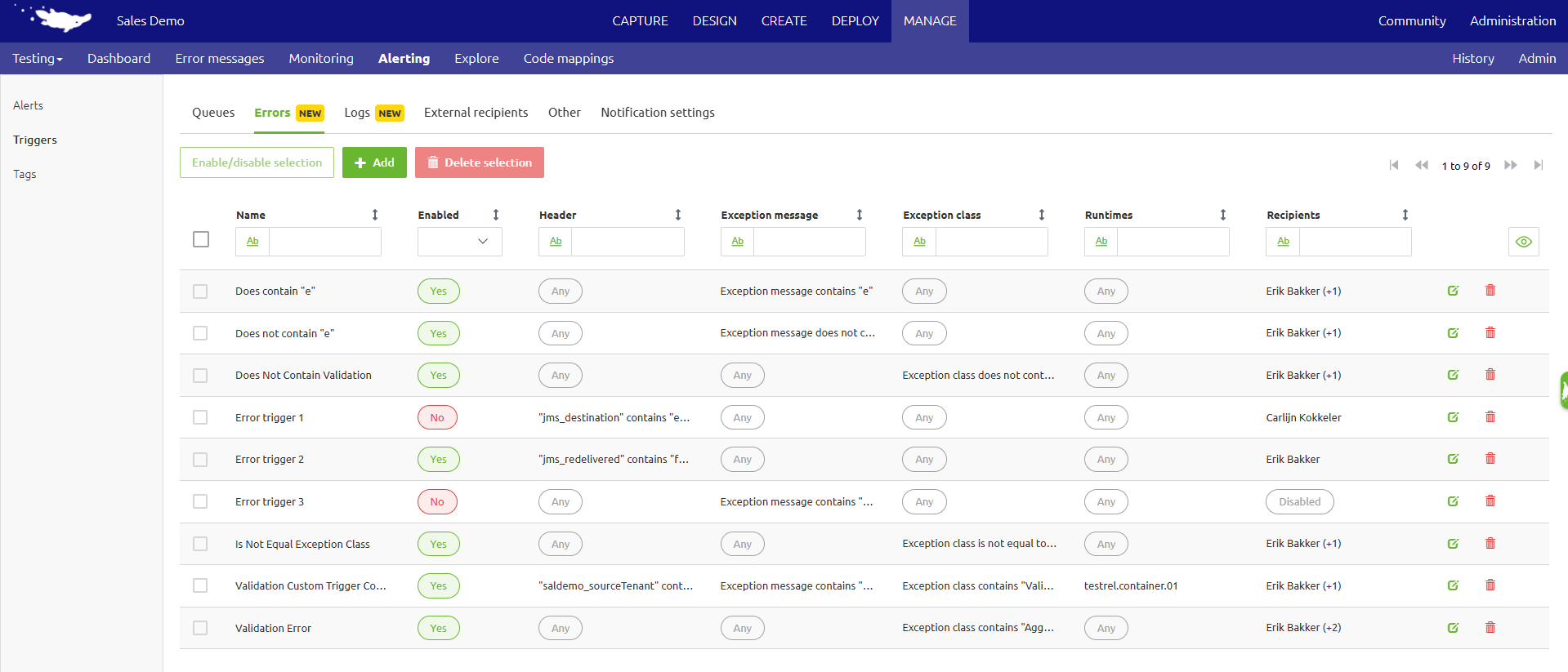
Similar to the queue alerting, you can find the overview of the error alerting by navigating to Manage->Alerting->Triggers, then under the "Errors" tab you will find all of the error alert triggers, if you have created them already, for the environment that you are working with at the moment (i.e., Testing, Acceptance, Production). To create a new error trigger, you can press the "Add" button. Otherwise, if you want to edit an existing error alert trigger, you can click the green edit button on the right side of each trigger.
eMagiz currently provides four checks that will raise an alert from the error messages, namely, by evaluating the Message header, Exception class, Exception message, and the Runtime where the error message is raised. In the following sections, we will discuss how you can create an error trigger and tune its trigger checks to match your needs.
3.1 Evaluate message header
This check evaluates whether an alert should be generated when an error message is raised based on the header contained in the message.
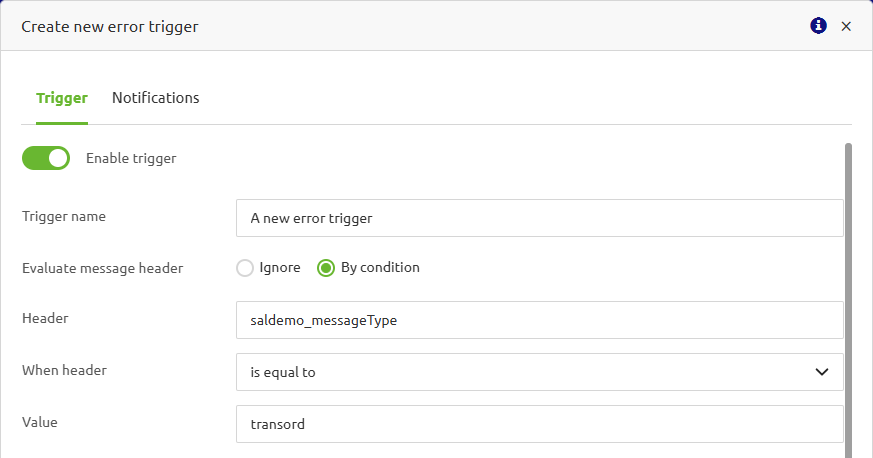
If you set it to "Ignore", then message headers will not be evaluated when deciding whether to raise an alert. If set to "By Condition," then you can specify what header name to evaluate and define conditions such as whether it equals, does not equal, contains, or does not contain a specific value to result in an alert.
3.2 Evaluate exception class
This check evaluates whether an alert should be generated based on the exception class of the error message when it is raised.
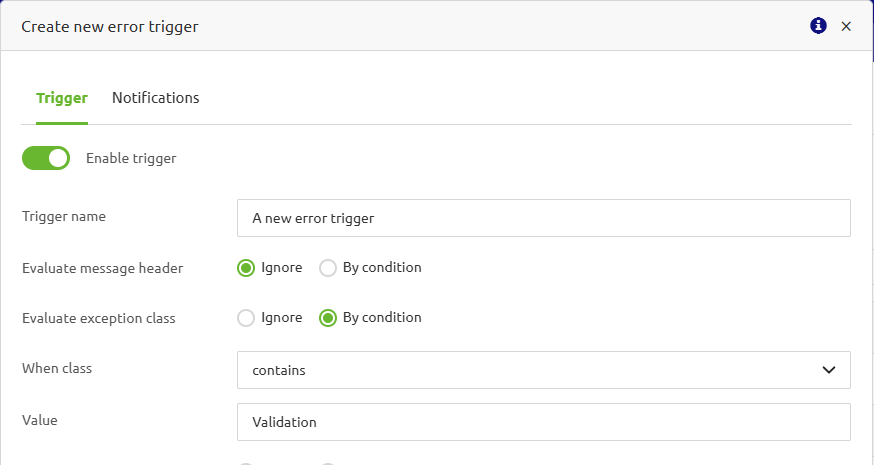
If you set it to "Ignore", then the exception class will not be evaluated when determining whether an alert should be raised. If set to "By Condition", then you can specify what exception class to evaluate and define conditions such as whether it equals, does not equal, contains, or does not contain a specific value to result in an alert.
3.3 Evaluate exception message
This check evaluates whether an alert should be generated based on both the first and last exception message of the error message when it is raised.
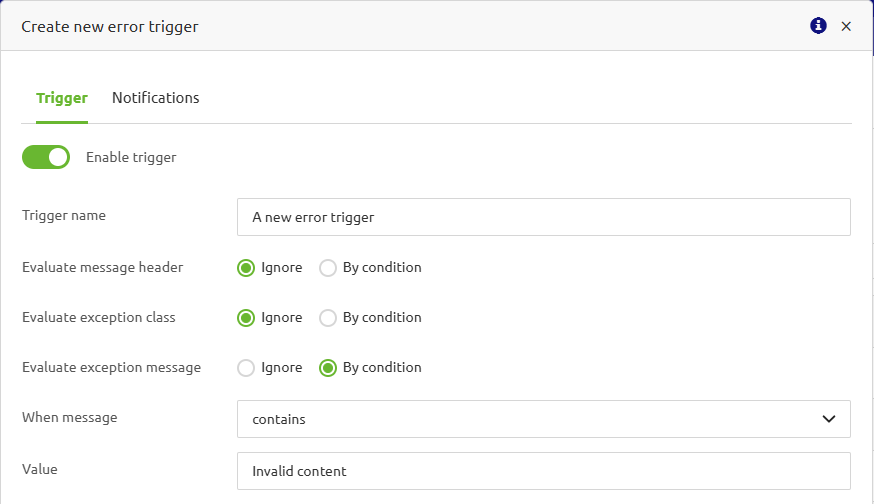
If you set it to "Ignore", then the exception message will not be evaluated when determining whether an alert should be raised. If set to "By Condition," then you can specify a string to check in both the first and last exception messages, and define conditions like equals, not equals, contains, or does not contain to result in an alert.
3.4 Runtime check
This check evaluates whether an alert should be generated when an error message is raised from which runtime in the environment.
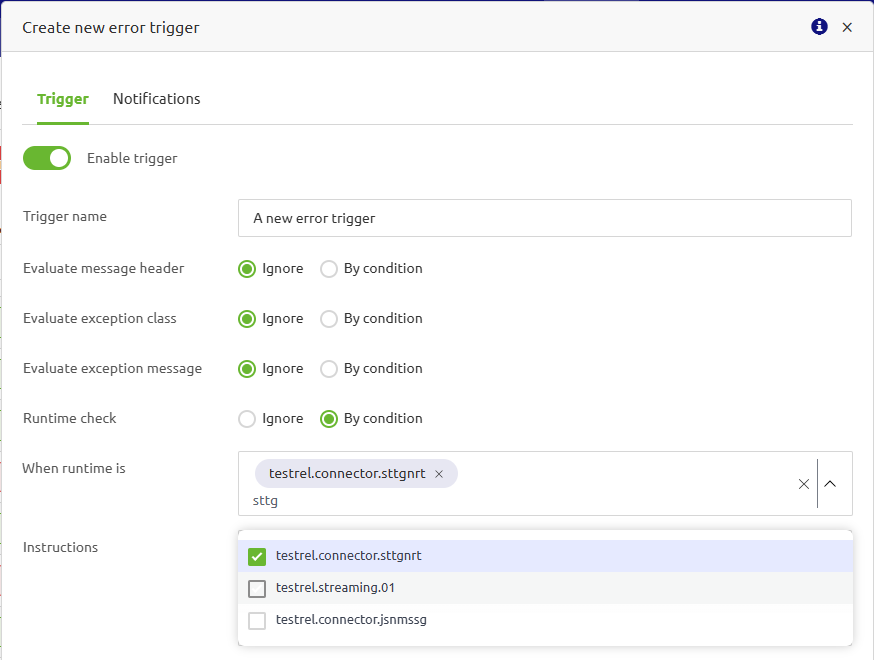
If you set it to "Ignore", then which runtime where the error occured will not be evaluated when determining whether an alert should be raised. If set to "By Condition", then you can specify which runtime where the error message occured to result in an alert.
3.5 Instruction
Additionally, you can also specify a custom instructions that will be included in both the email notifications sent to recipients as well as in the alert message displayed in the Manage->Alerting->Alerts.

Lastly, upon saving, these settings will apply immediately, putting the new error alert trigger into effect. Next to that, on this page, you can also find the "Notifications" tab that allows you to configure which recipients that you want to receive the notifications from the error alerting. If you want to learn more about this notifications and how to configure it, please refer to this microlearning.
4. Key takeaways
- eMagiz allows users to create and customize error alerts by defining triggers that will raise alerts and send notifications when error messages with specific conditions occur.
- eMagiz provides four checks for error alerts: message header, exception class, exception message, and runtime. These checks can be configured to evaluate conditions such as "equals," "not equals," "contains," or "does not contain" to determine if an alert should be triggered.
- Alerts are generated only if all specified checks in a trigger are met. Users can also configure recipients for error alert notifications, ensuring messages reach the appropriate stakeholders.
5. Suggested Additional Readings
If you are interested in this topic and want more information, please read the help text provided by eMagiz and read the following microlearning:
